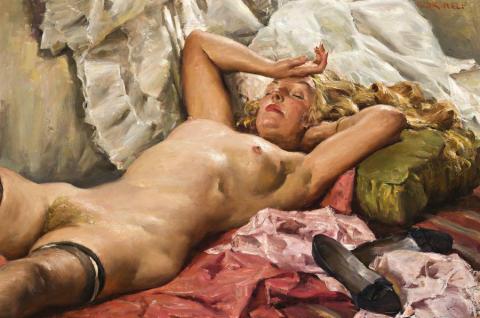THE BANGLE
IVOR HELE
oil on composition board
60.0 x 90.5 cm
signed upper right: IVOR HELE
Estate of the artist
Leonard Joel, Melbourne, 29 March 1994, lot 181
Private collection
Leonard Joel, Melbourne, 28 July 1998, lot 64
Private collection, Melbourne
In art, the female nude has commanded a long and fascinating history, revealing her times in countless images and ideas. The Paleolithic Venus of Willendorf gave hope of magical fertility; Titian's Venus of Urbino, 1538 was once thought of in the most seductive terms; and Picasso's Les Demoiselles d'Avignon, 1907 opened the way for a whole new path in Western art.1 Eve tantalized and transgressed; Cleopatra conquered Caesar; and Velàzquez's Rokeby Venus, 1651 survived the Spanish Inquisition and the later attacks of the suffragette Mary Richardson.2 Erotic appeal adopted many guises over the centuries, often flirting between concealment and open display, as a touch of velvet or transparent veil added to enticement.
A powerful sense of masculinity pervades Ivor Hele's work. One of Australia's most successful portrait painters - he won the Archibald Prize five times - his sitters, ranging from art gallery director Laurie Thomas to Sir Robert Menzies, are all images of men's men. The same is found in his self portraits, firm of jaw line and direct in look. The character of man and his physical prowess continued in his war pictures when official World War II artist in North Africa and New Guinea, and again in 1952 in Korea. In his large, 1954 commissioned painting of the opening of Federal Parliament by Queen Elizabeth II, it is not surprising to find it filled with the feeling of the monarch surrounded by all the Queen's men. And then there are his subject pictures such as The Pick Up, 1952, where ladies of Rubenesque endowment evoke moments of classical mythology in a kind of contemporary golden age where nudity, freedom, and energy abound. It is a good life to be lived to the full, and woman is man's desirable partner in all her physicality.
In his love of the human figure, drawings and paintings of the female nude make up a major part of Hele's oeuvre. As in The Bangle, each has a spontaneity that adds to their appeal. This is found as much in the imagery as in the brilliant technique. A caressing line excites a drawing's masterly draughtsmanship. The active play of light over body and garments in The Bangle combines with the dé shabillé, of moments of passion past captured in recollection. The pose, nevertheless, invites desire through its glistening, provocative splendour, enticed by the gartered top to the black stocking and discarded patent shoes casually composed nearby. Ivor Hele's mastery of the erotic, so redolent of the 1960s, challenges the best of any Australian artist.
1. In the collections of the Naturhistorisches Museum, Vienna, and the Galleria degli Uffizi, Florence, respectively.
2. National Gallery, London
DAVID THOMAS
